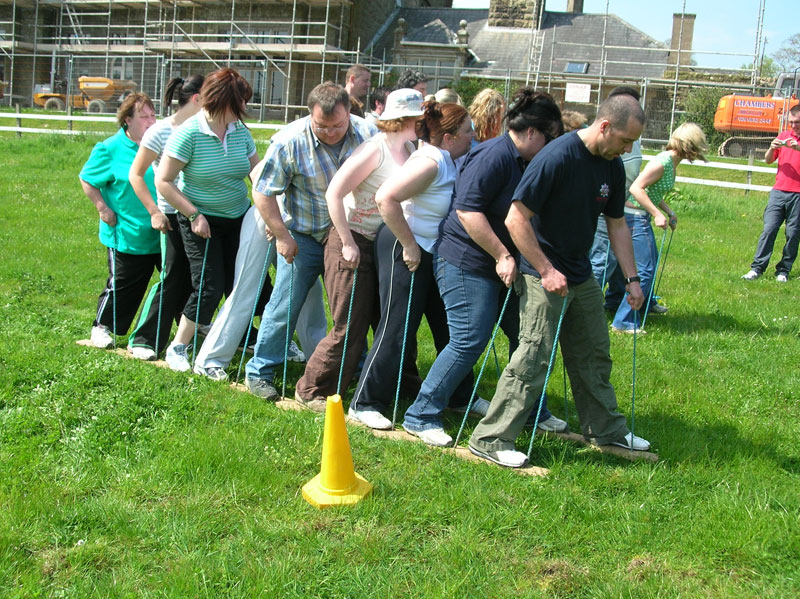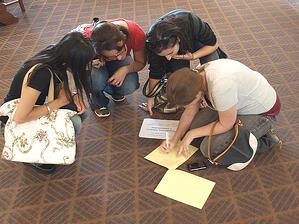If you’ve been in the workforce for a while, chances are you’ve attended or, depending on your perspective, been subjected to a corporate team building retreat at some point in your career. Do any of these old standards strike a chord?

Trust Fall
Close your eyes … cross your arms across your chest … relax your body … and now, releasing all of your fears, doubts, and paranoia, simply let yourself fall, backwards, into the waiting arms of your trusted new co-worker, What’s-His-Name.
Shipwreck
Shipwreck: You and 12 of your colleagues have been in a shipwreck. (It’s always something.) The good news is, there’s a life raft. The bad news is, there’s only enough room on the raft for six of you. Who gets to stay?
Minefield
You’ve stumbled upon a minefield and there’s no turning back. Oh, and by the way (did we mention?) you’re blindfolded. Now you must cross the minefield with only your teammates’ verbal instructions, from the sidelines, to guide you to safety.
• • •
Welcome to “team building,” which can either be a fun and welcome reprieve from the workaday routine of the cubicle … or your worst nightmare, depending on your personality and perspective.
Teamwork is every manager’s goal. Still, we can’t help but wonder: in this day and age, is “team building” still a thing?”
Indeed it is. But first, a little history.
Back in the 1920s and ‘30s, Harvard Business School Professor Elton Mayo set out to identify the factors that influenced productivity in the workplace. To learn what made assembly line workers tick, Mayo focused on a group of women employed by the Hawthorne Works, a Western Electric factory in Cicero, Illinois. After observing the women under a variety of circumstances, Mayo concluded that the most important factor—more important than money, more important than working conditions, more important than perks—was teamwork: a sense of group identity, a feeling of social support, and the cohesion that comes with increased worker interaction.
Managers have been tweaking Mayo’s findings for 85 years, but the basic tenets of the so-called “Hawthorne Experiments” still hold up. On-the-job productivity and performance improve when workers:
- share a common purpose;
- cooperate and collaborate to achieve common goals;
- take pride in their accomplishments;
- feel they have some control over the decisions that affect their work lives;
- sense that their managers care about them.
Teamwork: Everyone wants it, but how do you get it?
 An entire industry has grown up around the idea of corporate team building. There are even trade groups—like the International Association of Teamwork Facilitators—for professionals who specialize in helping companies build teams. One thing we’ve learned since the Hawthorne Experiments is that teamwork does not just “happen.” A company has to actively foster it. To do so, managers through the ages have turned to team-building retreats—often facilitated by a hired consultant—as a chance to step back, take stock, and focus on relationships, away from the office.
An entire industry has grown up around the idea of corporate team building. There are even trade groups—like the International Association of Teamwork Facilitators—for professionals who specialize in helping companies build teams. One thing we’ve learned since the Hawthorne Experiments is that teamwork does not just “happen.” A company has to actively foster it. To do so, managers through the ages have turned to team-building retreats—often facilitated by a hired consultant—as a chance to step back, take stock, and focus on relationships, away from the office.
While there’s no one formula for the “perfect” team building retreat, there are some guidelines that can help make your retreat a success.
If you’re going on a retreat, go on a retreat.
A retreat, by definition, should be a getaway—a chance for workers to escape from the day-to-day responsibilities and distractions of the office environment. Therefore, whether it’s for a few hours or a whole week, a retreat should be off-site, where people can focus their full attention on the team building at hand. Transportation to the venue sets the tone for the entire retreat, so it’s best for the group to travel together and even better if no one has to drive. Many companies find charter buses to be a cost-effective, comfortable, and convenient option for groups.
Find the right spot.
Location matters. The venue doesn’t have to be elaborate or pricey, but a retreat should be in a setting that is conducive to creativity and openness. To that end, the setting should be pleasant, with a seating arrangement that allows participants to see, hear, and interact with one another. (A circle works well.) There should be natural light, room to move around, and good food—factors that have been proven to contribute to the energy and good will that fuel any successful retreat. If possible, stay overnight. There is something magical about “sleeping on” a topic or problem and waking refreshed to tackle it anew.
Focus, focus, focus.
Successful team building retreats have a clear purpose—not just an amorphous desire to build a team. Unlike recreational outings (which serve their own important purpose), team building retreats require well-defined goals that are tied to the actual work of the organization. With a clear focus, a team building retreat can help the group look at challenges and opportunities from a new perspective, and go back to work with new energy and ideas.
Set an agenda and share it with participants ahead of time.
Your team building retreat needs an agenda, complete with:
- the purpose of the retreat and desired outcomes;
- team building activities;
- meaningful discussion topics;
- plenty of time for fun;
- a follow-up action plan.
Don’t overload the agenda. Leave time for people to socialize or go for a walk in the woods. Distribute the agenda in advance to (a) head off confusion, speculation, or even resistance; (b) generate enthusiasm and buy-in before the event.
Choose meaningful team building activities.
 Team building activities don’t have to be cheesy or awkward. There are thousands of creative options that actually relate to real-world problem solving, decision-making, negotiation, and collaboration skills. For example:
Team building activities don’t have to be cheesy or awkward. There are thousands of creative options that actually relate to real-world problem solving, decision-making, negotiation, and collaboration skills. For example:
- Build a dollhouse or bicycle and donate it to a charity.
- Perform improvisational comedy sketches.
- Go on an all-day scavenger hunt.
Build in follow-up.
Have you ever come home from a training session or retreat all fired up, only to have your enthusiasm fizzle once you get back to work? To avoid this all-too-common outcome, be sure to leave the retreat with clear next steps and a plan for tracking follow-up.
Elton Mayo revolutionized our understanding of human resources. When a group of workers become a cohesive team, their productivity and job satisfaction increase. When people invest the time and energy to work on their professional relationships on a retreat, away from the office, it changes the way they relate to each other at work—for the better. And that’s a good thing.

